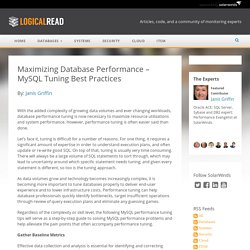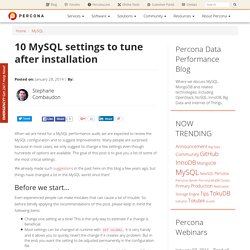

How to Install MariaDB and Configure for Best Performance on Ubuntu & CentOS? Let’s learn how to install and configure MariaDB, an open-source popular MySQL Relational Database Management System (RDBMS).

It is community developed and has the option of commercial support. MariaDB has been intended to remain highly compatible with MySQL though there are some deviations. In this article, we’ll be covering the installation and configuration of MariaDB on Ubuntu 20.x and CentOS 7.x/8.x and at the end will review some best practices for securing and improving its performance. MariaDB on Ubuntu On Ubuntu 20.x, MariaDB is available directly from its default repositories. First update apt repositories data by: Once repository data is updated, run: $ sudo apt install mariadb-server This will install MariaDB and required packages.
Do you want to continue? MariaDB on CentOS 7.x For CentOS 7.x, the available MariaDB version from the default CentOS repository is 5.x. For this, we need to first configure an additional yum repository. Swap sous Linux avec MySQL - ArKZoYd. Maximizing Database Performance – MySQL Tuning Best Practices. With the added complexity of growing data volumes and ever changing workloads, database performance tuning is now necessary to maximize resource utilizations and system performance.

However, performance tuning is often easier said than done. Let’s face it, tuning is difficult for a number of reasons. For one thing, it requires a significant amount of expertise in order to understand execution plans, and often update or re-write good SQL. On top of that, tuning is usually very time consuming. There will always be a large volume of SQL statements to sort through, which may lead to uncertainty around which specific statement needs tuning; and given every statement is different, so too is the tuning approach.
As data volumes grow and technology becomes increasingly complex, it is becoming more important to tune databases properly to deliver end-user experience and to lower infrastructure costs. Gather Baseline Metrics Examine the Execution Plan Review the Table and Index. 10 MySQL settings to tune after installation. When we are hired for a MySQL performance audit, we are expected to review the MySQL configuration and to suggest improvements.

Many people are surprised because in most cases, we only suggest to change a few settings even though hundreds of options are available. The goal of this post is to give you a list of some of the most critical settings. We already made such suggestions in the past here on this blog a few years ago, but things have changed a lot in the MySQL world since then! Before we start… Even experienced people can make mistakes that can cause a lot of trouble. Change one setting at a time! Basic settings Here are 3 settings that you should always look at. Innodb_buffer_pool_size: this is the #1 setting to look at for any installation using InnoDB.
Innodb_log_file_size: this is the size of the redo logs. Starting with innodb_log_file_size = 512M (giving 1GB of redo logs) should give you plenty of room for writes. MySQL Innodb notes de configuration et d’optimisation. Pour connaitre la taille d'une table ou d'une de vos bases MySQL en ligne de commande.
Transactions on InnoDB » Blog Archive » InnoDB Performance Schema. Performance Schema Support in InnoDB With the plugin 1.1 release, InnoDB will have full support of Performance Schema, a new feature of MySQL 5.5 release. This allows a user to peak into some critical server synchronization events and obtain their usage statistics. On the other hand, in order to make a lot of sense of the instrumented result, you might need some understanding of InnoDB internals, especially in the area of synchronization with mutexes and rwlocks.
With this effort, the following four modules have been performance schema instrumented. 1. 2. 3. 4. Almost all mutexes (42), rwlocks (10) and 6 types of threads are instrumented. This blog is to give you a quick overview on this new machinery. To start with, you probably want to take a quick look at MySQL’s Performance Schema Manual ( ), this gives you a quick overview on the general performance schema features. The performance schema is by default built in with MySQL 5.5 release. It could also display message such as: name. MySQLTuner - MySQLTuner. 10 MySQL settings to tune after installation.